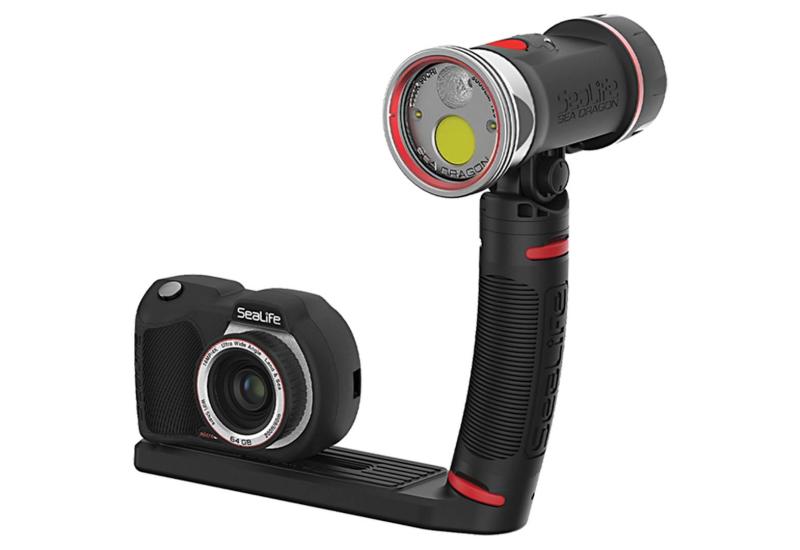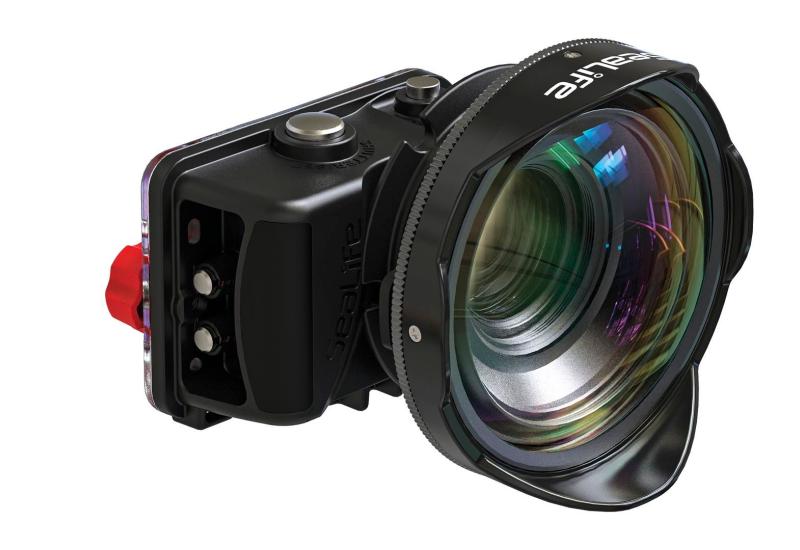What the Pros Shoot
September 2006
By Stephen Frink
||
|---|
|

|
| Photo by Stephen Frink|
A good friend and pro photographer, Jerry Greenberg, dropped by my studio recently. As so often happens between those of us who make our living with underwater cameras, the chat migrated to the gear we use to do our job. Jerry still embraces film and his familiar workflow for cataloging images. However, in his 50-plus years of shooting (he wrote Underwater Photography Simplified in 1956), he has tried almost all of the various housings and amphibious cameras available for film including one of his own manufacture, the Seahawk for the Leica rangefinder. He has gone through a veritable arsenal of underwater systems, including Rolleimarin, Oceaneye, Oceanic, and all iterations of Nikonos from Calypso to Nikonos V. Over the years, he has refined his gear to fit his vision and style of diving. Interestingly, today his gear includes an eclectic mix of Nikonos, Sea & Sea, Aquatica and Ikelite gear, each fit for a particular kind of subject.
I have taken a completely different road and migrated totally to digital equipment, shooting the Canon EOS-1DsMKII in a Seacam housing, with strobes by both Ikelite and Inon. The vast differences in the tools we've selected to capture our underwater photos made me wonder what other professional underwater photographers are using today--what do the pros shoot?
The short answer is that there is probably no consensus because each shooter chooses his or her system based on individual needs. However, their choices are a fascinating insight into the state of the art in underwater cameras, housings and strobe systems today.
Here's what a select group of working pros are shooting today, in their own words.
Chris Crumley

What He Shoots: Canon EOS-1DsMKII
Housing: Seacam
Strobes: Ikelite DS-125
My photos are used in a wide variety of format sizes, mostly advertising with some editorial, so I depend on high-end digital systems. For land work, my choice is a 22-megapixel digital back on a Hasselblad H2 and for underwater, Canon EOS-1DsMKII bodies. Two Canons back up each other for underwater work and they also back up the Hasselblad. Backup systems are critical to photo shoots with a crew on location.
A good share of my in-water work is split-perspective, so my choice of housings is influenced by that type work. My last four housings have been Seacams with nine-inch glass ports and a 45-degree optical finder that swivels quickly and easily for horizontal or vertical orientation. This 45-degree finder also allows me to shoot many of the under/over images with my head above water.
Lighting is critical, deep or shallow, and I've been extremely pleased using multiple Ikelite DS-125 substrobes in most situations. I tend to shoot fast, and the DS-125s have extremely short recycle times. DS-125s are also small and light.
Doug Perrine

What He Shoots: Canon EOS 20D, Canon EOS 5D
Housings: Subal and Ikelite
Strobes: Ikelite DS-125 and Inon Z220
I update my equipment every couple of years as technology advances. I am currently using Canon EOS 20D and EOS 5D cameras in Subal and Ikelite housings with Ikelite DS-125 and Inon Z220 strobes. The Subal housing gives me a finely machined compact metal housing with an enlarging optical viewfinder and glass ports at a premium price, while the Ikelite housings give me TTL flash exposure and access to a wide variety of acrylic ports at a very affordable price. The Inon strobes are extremely compact and use readily exchangeable AA batteries, while the Ikelite strobes give me modeling lights and TTL when used with Ikelite housings. Both types recycle extremely quickly and offer multiple manual power settings. My workhorse lenses are the Canon 15mm fisheye, 10-22mm zoom, 17-85mm zoom, and 60mm macro, and the Sigma 14mm rectilinear fisheye.
Mauricio Handler

What He Shoots: Nikon D2X
Housing: Aquatica
Strobes: Ikelite 200 and MS-50
As soon as digital came around, I took the leap of faith with the Nikon D100 and now I use the D2X, which is a marvelous piece of engineering. I see no returning to film, although I am the first to admit that I sometimes miss the simplicity of the medium. I have used Aquatica housings, ports and accessories for more than 20 years and have trusted them exclusively with protecting my cameras underwater. My new Black Aquatica D2X is a gem of a housing--plus it just looks cool. I have used Ikelite strobes exclusively and continue to use and rely on my Ikelite 200s for all my work with a few small MS-50s for backlighting.
Chris Newbert

What He Shoots: Subeye Reflex
Strobes: Ikelite DS-125, Ikelite 200 substrobe
I've been taking pictures underwater for over 30 years. In this time I've made exactly one change in my core camera system. I started with Canon F1s and stayed with them for more than 20 years. I am now using the Subeye Reflex, the camera I will continue to use until I retire or die, whichever comes first. The Subeye is a simple film camera that offers the widest range of lens choices of any underwater camera ever made. It can accept any Nikon AF lens with appropriate port, plus all the Nikonos RS water-contact lenses, but it does not permit autofocus with either. Instead, it offers a thumb-controlled power manual focus. The Subeye's sole "advanced" feature is TTL strobe exposure control. Additionally, it has power wind, a shutter speed control, an aperture control, an ISO control that is also used for exposure compensation when shooting TTL strobe, and of course a trigger. And that's it. It's unencumbered by any of the bells and whistles that I find unnecessary to take a good photo in the first place. My strobes of choice for close-up photography are the compact Ikelite DS-125s with their lightning-fast recycle time. For wide-angle, I prefer the increased power and beam angle of the Ikelite 200 substrobes.
Amos Nachoum

What He Shoots: Nikonos RS, Nikonos III
I still use the Nikonos RS thanks to the excellent optics this camera features. It has an excellent light meter and a large viewfinder, which is critical for capturing big animals at my advanced age. I also still use the Nikonos III with the 15mm and 20mm lenses, which offer superb optics. Both cameras are always reliable and very easy to handle and put together in any environment from the North Pole to Antarctica. These two cameras are superb to work with in blue water and particularly with big animals. I've resisted moving to digital, in part because of cost, in part because digital images seem two-dimensional to me, while film renders a more three-dimensional feel that's more appealing to me.
Brandon Cole

What He Shoots: Canon EOS-1DsMKII and Canon EOS 5D
Housing: Seacam
Strobes: Ikelite DS-125 and 200
The last few years have seen me changing photo gear at a frenzied pace. Seems I've hardly had time to learn the nuances of one camera before moving on to the next. I've recently transitioned exclusively to full-frame digital SLRs and hope to stick with these for a year or two.
My lens arsenal is always being fine-tuned. As I shoot primarily big animals and wide-angle scenes, full-frame fisheye, 17mm, 20mm primes and the 17-40mm zoom get the most action. Like many others, I'm on a quest for wide-angle lenses that hold up to the demands of full-frame sensors. Austrian-made Seacam housings remain my first choice to keep cameras dry. When I need to bring the sun underwater, I turn to Ikelite DS125 and 200 substrobes for their reliability and the company's stellar customer service.
Eric Cheng

What He Shoots: Canon EOS-1DsMKII
Housing: Seacam
Strobes: Ikelite DS-125
I shoot with a Canon EOS-1DsMKII in a Seacam underwater housing, with Ultralight arms and Ikelite DS-125 strobes for lighting. I love Seacam housings because everything is always right at my fingertips. I can zoom, focus, change both aperture and shutter speed, and trigger the shutter without moving either of my hands away from their position gripping the handles. The Ikelite DS-125 strobes are a good compromise between size, battery life, beam angle and power. Most of the time these days, I feel like I've achieved underwater equipment nirvana, which is to feel like I never have to think about what I shoot. Gear should never get in the way between me and an image I want to capture!
Flip Nicklin
What He Shoots: Nikon D2X
Housing: Nexus
I have changed systems every year for the last three years. The big files and bigger buffer on the D2X really make a difference. Being down deep on a free dive near a whale and waiting after shooting four frames got pretty old. Also on the D2X housing, I can see through the viewfinder very well. The D70 was terrible--lucky for me that whales are big and I usually shoot pretty wide. I use big ports with extenders to match them up well with the lens.
Eric Hanauer

What He Shoots: Nikon D100
Housing: Subal
Strobes: Ikelite DS-125
By the time you read this, I will have updated to a Nikon D200 and a Subal housing. I've been shooting a D2X topside, and the D200 offers the same fast, accurate autofocus and metering, along with 10-megapixel resolution. It will be my fourth Subal housing. I really like the compact size of the Subal because it handles like a camera instead of like a housing. I've been using Ikelite strobes ever since the 150, and these are the best yet, with soft, even, warm light and incredibly quick recycle times.
David Fleetham
What He Shoots: Canon EOS 20D
Housing: Ikelite
Strobes: Ikelite DS-125
I am currently shooting with a Canon EOS 20D in an Ikelite housing with twin Ikelite substrobes. I tested Ikelite's digital TTL 125 substrobes when they first perfected the electronics with the 20D. I was so impressed I've been clicking away with the same system ever since.
I now shoot most of my wide-angle in TTL and even when the subject does not fill the frame, the TTL strobes still get it 99 out of 100 times. The Canon 5D is in my very near future and I'll put it in an Ikelite housing again. I miss my true full-frame fisheye and will go for the 5D to get it back.
Andy Sallmon

What He Shoots: Canon EOS 5D, Canon EOS 20D
Housings: Aquatica and Sea & Sea
Strobes: Sea & Sea YS-120
I am a recent Canon convert. I really like the full-frame sensor and small size of the 5D. Canon seems to have a faster, more responsive autofocus and I also like the low noise and "smooth" look from their CMOS sensor. The 5D handles beautifully underwater in both the new Aquatica housing and the new Sea & Sea housing. I like the Aquatica's handles--the best of all handles in the industry--and have heard that they will eventually produce a magnified viewfinder. The Sea & Sea housing just "landed" in the U.S. It is a little smaller than the Aquatica and will soon have i-TTL capability with the new Sea & Sea Canon TTL converter. The small size and weight of both of these housings make them equally great whether packing them for travel or swimming after dolphins.
My underwater lens choices for wide-angle are the 15mm full-frame fisheye and the 20mm wide-angle. I love the 180-degree viewing angle of the 15mm for reef scenics, wrecks and large animals like whales and whale sharks. The 20mm is a favorite wide-angle at 94 degrees as it's not too wide but forces you to work close to your subject. I like this lens for sharks and dolphins, yet it's wide enough for some reef scenics.For macro, I prefer the Canon 100mm USM IF. It's got the fastest autofocus response in a macro lens that I've ever used.
Since I travel a lot and compactness and weight are always an issue, I have room for only one telephoto lens. For this application, I have found the Canon 100-400 IS tele-zoom to be the best single lens that I could carry. It offers a long focal length with my 20D body, which is now my topside camera, and the image stabilization comes in handy when shooting in low-light situations where high shutter speeds are not needed.
Rod Klein

What He Shoots: Nikon D2X
Housings: Subal and Nexus
Strobes: Inon 220 and 240 series
A longtime Nikon shooter, I have progressed from the D100 to the D2X. In fact, I have two D2X cameras for underwater and a D200 for general-purpose use. While some photographers prefer cameras with a full-frame image sensor, I like Nikon's smaller DX sensor technology. Considering that Nikon has created wide-angle lenses specifically for the smaller DX sensor, I feel I get more bang for my buck when shooting macro and still have all the lenses I need for wide-angle situations.
I use a Subal housing for my D2X. It's extremely well-built with virtually every camera control available, a very convenient removable camera tray, easy-access lens release, and what I consider to be the easiest latching system to use. I love this housing, especially for macro work. I recently added a Nexus D2X housing to my arsenal, primarily for wide-angle use. It's an extremely small housing and has a newly designed glass wide port that measures only six inches but will accommodate all of the Nikon wide lenses. This makes for very easy packing and reduced weight. It's great for one-hand shooting.
I've been a confirmed Inon strobe user since the first 220 series strobes were introduced. They're half the size of a Nikonos 105, but have more power, multipower settings, and 100-degree coverage, so I can easily pack four strobes in the same space that two larger strobes might take. And because they are so small, I actually use three strobes when shooting wide-angle, which gives me better lighting control in the center of the frame. I recently added the new Inon 240 series strobes to my system. They have a higher guide number and a built-in pointer light that is completely separate from the camera shutter electronics.
David Doubilet

(text by Jennifer Hayes)
What He Shoots: Nikon F100, Nikon F4, Nikon D100, Nikon D70, Nikon D2X
Housings: Nexus and Seacam
Strobes: Sea & Sea YS-200 YS-120, YS-350, DX-90
David is shooting about 80 percent digital on assignment with the exception of panoramic and black-and-white imagery. David is digitally armed with the Nikon D100 through the D2X housed in Nexus and Seacam Housings and uses Sea & Sea YS-350 and DX-90 strobes on Aquatica arms. His bag is crowded with a complement of lenses ranging from 10.5mm Nikon AF-D through to the 105mm Nikon complete with backups and a handy 300mm Nikon for just-in-case surface moments.
His film-related gear has been modified to Nikon F100s, F4s in Nexus housings and the Hasselblad X-pan Panoramic in a custom housing. David still relies on his favored Sea & Sea YS-200 strobes equipped with wet connectors and backs them up with Sea & Sea YS-120s.
Walt Stearns

What He Shoots: Canon EOS 5D
Housing: Subal
Strobes: Sea & Sea YS-120
Among the criteria I used in selecting a housing were the overall balance, weight and size of the housing, the construction and operational ergonomics of the camera controls and the availability of optics that would allow for expansion and maximum versatility. Because I am now shooting with Canon's compact 12.8-megapixel powerhouse, the 5D, Subal's just-released housing was the most obvious choice. It's small and lightweight, making it relatively travel-friendly. Furthermore, it's well- balanced and offers easy access to the camera's controls. But most important of all, it includes premium-quality ports. Between Subal's FE2 optical-grade-glass dome port and macro port with a couple of extension rings, I am able to use premium optics such as Canon's 15mm full-frame fisheye, 17-40mm wide-angle zoom, 24mm prime and 100mm macro. The transition to digital hasn't changed my lighting needs. I still use dual Sea & Sea YS-120 strobes, set on a pair of TLC arms.
Paul Nicklen

What He Shoots: Canon EOS-1DMKII and Canon EOS-1DsMKII
Housings: Seacam
Strobes: Ikelite DS-125
All of the assignments that I have shot for National Geographic have been in very remote and inhospitable places such as the Arctic and Antarctica. Originally, because of the remoteness and the limitations of film, I used to shoot with five or more film housings. That meant I needed 10 strobes--way too much gear and too many headaches. I have always found underwater photography labor- and gear-intensive.
Two years ago, I switched to the Seacam 1Ds and 1D housings with the fisheye port, superdome and macro port. These are no doubt the Bentleys of underwater housings, and for the first time in a long time, I love taking underwater pictures again. The ease of use, the incredibly sharp images with the mineral glass domes and mostly the unparalleled 180- and 45-degree viewfinders make these housings an underwater photographer's dream.
The 1DMKII system works perfectly with the Canon 16-35mm zoom, and I use the 17-40 zoom on the 1Ds system. I also shoot the 15mm fisheye on either housing and like both the Sigma 50mm and Canon 100mm macro lenses. With the ease of changing my ISO settings underwater and the ability to see what my strobes are doing, I no longer lug around huge strobes. These days, I am very happy with my Ikelite DS-125 digital strobes. Underwater photography is becoming so much fun that I almost feel guilty--but I don't.
September 2006
By Stephen Frink
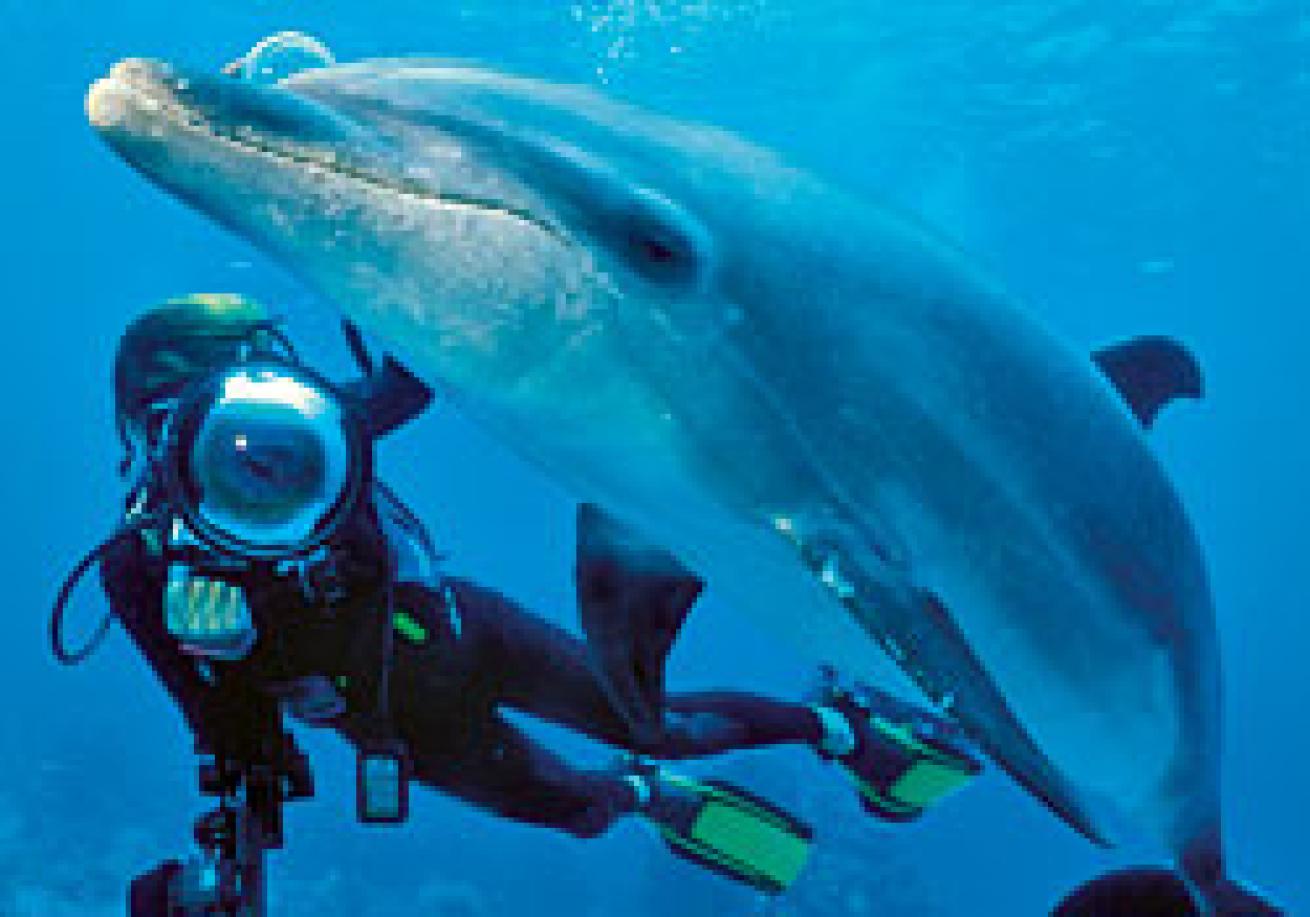
| | Photo by Stephen Frink| A good friend and pro photographer, Jerry Greenberg, dropped by my studio recently. As so often happens between those of us who make our living with underwater cameras, the chat migrated to the gear we use to do our job. Jerry still embraces film and his familiar workflow for cataloging images. However, in his 50-plus years of shooting (he wrote Underwater Photography Simplified in 1956), he has tried almost all of the various housings and amphibious cameras available for film including one of his own manufacture, the Seahawk for the Leica rangefinder. He has gone through a veritable arsenal of underwater systems, including Rolleimarin, Oceaneye, Oceanic, and all iterations of Nikonos from Calypso to Nikonos V. Over the years, he has refined his gear to fit his vision and style of diving. Interestingly, today his gear includes an eclectic mix of Nikonos, Sea & Sea, Aquatica and Ikelite gear, each fit for a particular kind of subject.
I have taken a completely different road and migrated totally to digital equipment, shooting the Canon EOS-1DsMKII in a Seacam housing, with strobes by both Ikelite and Inon. The vast differences in the tools we've selected to capture our underwater photos made me wonder what other professional underwater photographers are using today--what do the pros shoot?
The short answer is that there is probably no consensus because each shooter chooses his or her system based on individual needs. However, their choices are a fascinating insight into the state of the art in underwater cameras, housings and strobe systems today.
Here's what a select group of working pros are shooting today, in their own words.
Chris Crumley
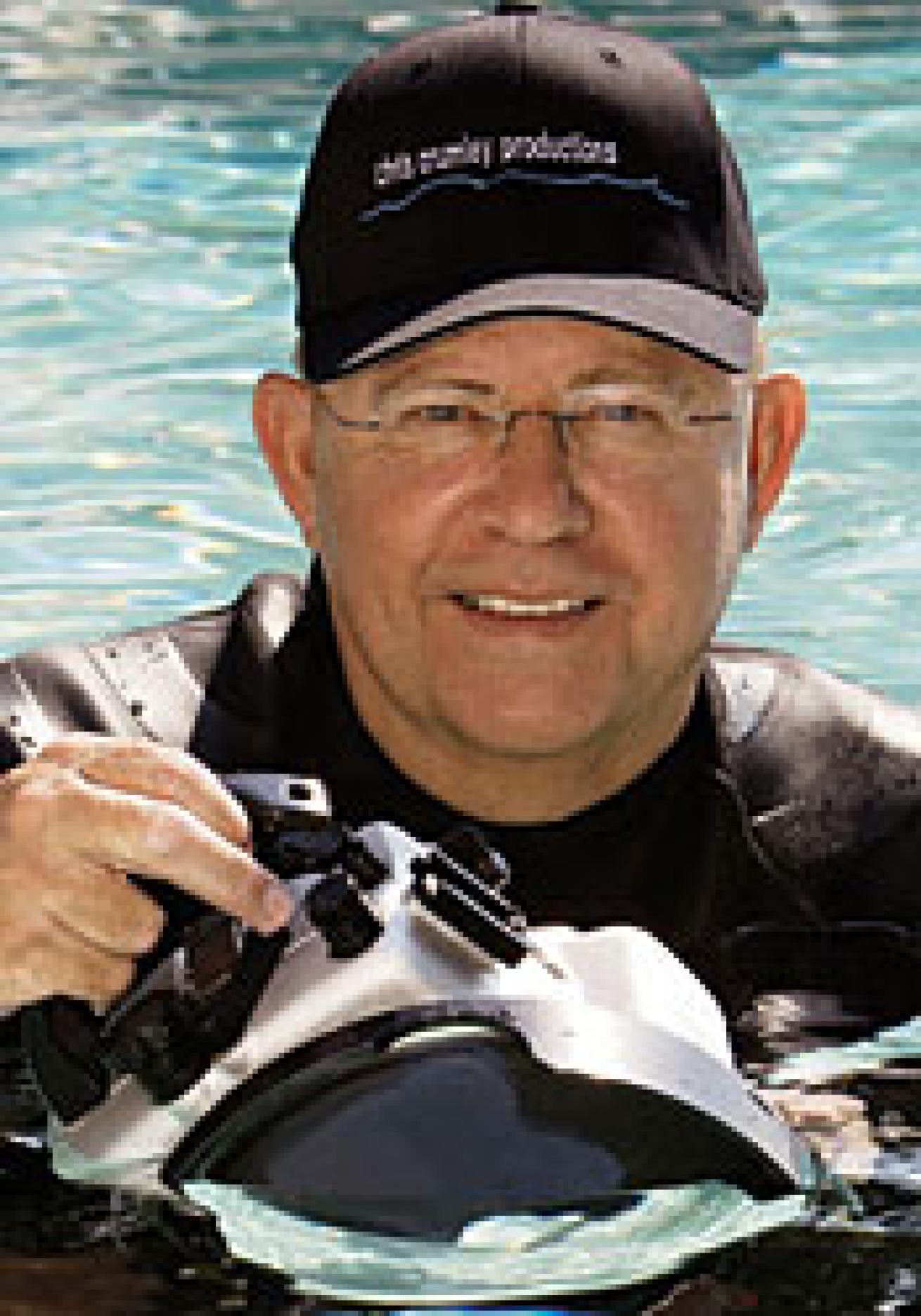
What He Shoots: Canon EOS-1DsMKII
Housing: Seacam
Strobes: Ikelite DS-125
My photos are used in a wide variety of format sizes, mostly advertising with some editorial, so I depend on high-end digital systems. For land work, my choice is a 22-megapixel digital back on a Hasselblad H2 and for underwater, Canon EOS-1DsMKII bodies. Two Canons back up each other for underwater work and they also back up the Hasselblad. Backup systems are critical to photo shoots with a crew on location.
A good share of my in-water work is split-perspective, so my choice of housings is influenced by that type work. My last four housings have been Seacams with nine-inch glass ports and a 45-degree optical finder that swivels quickly and easily for horizontal or vertical orientation. This 45-degree finder also allows me to shoot many of the under/over images with my head above water.
Lighting is critical, deep or shallow, and I've been extremely pleased using multiple Ikelite DS-125 substrobes in most situations. I tend to shoot fast, and the DS-125s have extremely short recycle times. DS-125s are also small and light.
Doug Perrine
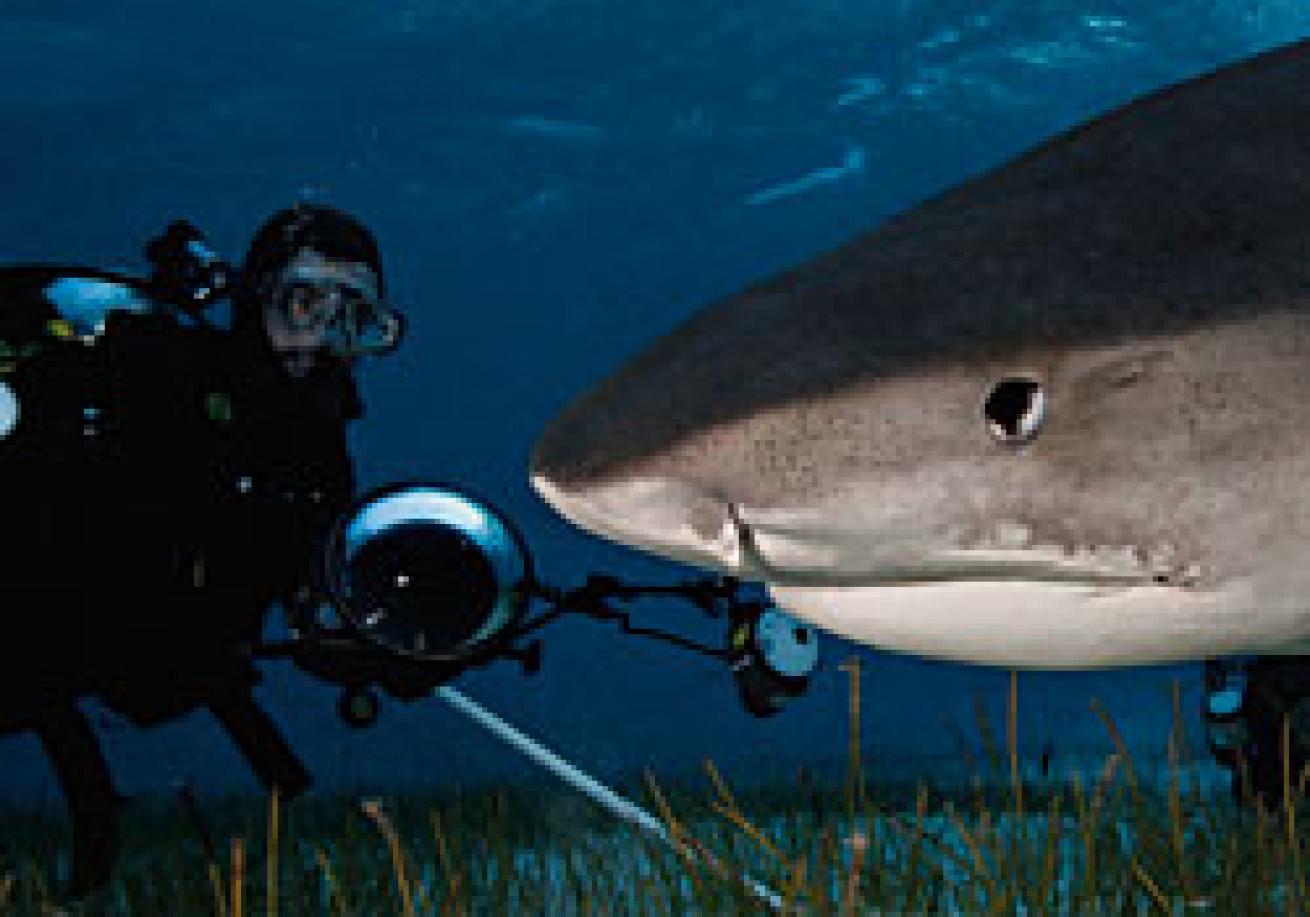
What He Shoots: Canon EOS 20D, Canon EOS 5D
Housings: Subal and Ikelite
Strobes: Ikelite DS-125 and Inon Z220
I update my equipment every couple of years as technology advances. I am currently using Canon EOS 20D and EOS 5D cameras in Subal and Ikelite housings with Ikelite DS-125 and Inon Z220 strobes. The Subal housing gives me a finely machined compact metal housing with an enlarging optical viewfinder and glass ports at a premium price, while the Ikelite housings give me TTL flash exposure and access to a wide variety of acrylic ports at a very affordable price. The Inon strobes are extremely compact and use readily exchangeable AA batteries, while the Ikelite strobes give me modeling lights and TTL when used with Ikelite housings. Both types recycle extremely quickly and offer multiple manual power settings. My workhorse lenses are the Canon 15mm fisheye, 10-22mm zoom, 17-85mm zoom, and 60mm macro, and the Sigma 14mm rectilinear fisheye.
Mauricio Handler

What He Shoots: Nikon D2X
Housing: Aquatica
Strobes: Ikelite 200 and MS-50
As soon as digital came around, I took the leap of faith with the Nikon D100 and now I use the D2X, which is a marvelous piece of engineering. I see no returning to film, although I am the first to admit that I sometimes miss the simplicity of the medium. I have used Aquatica housings, ports and accessories for more than 20 years and have trusted them exclusively with protecting my cameras underwater. My new Black Aquatica D2X is a gem of a housing--plus it just looks cool. I have used Ikelite strobes exclusively and continue to use and rely on my Ikelite 200s for all my work with a few small MS-50s for backlighting.
Chris Newbert
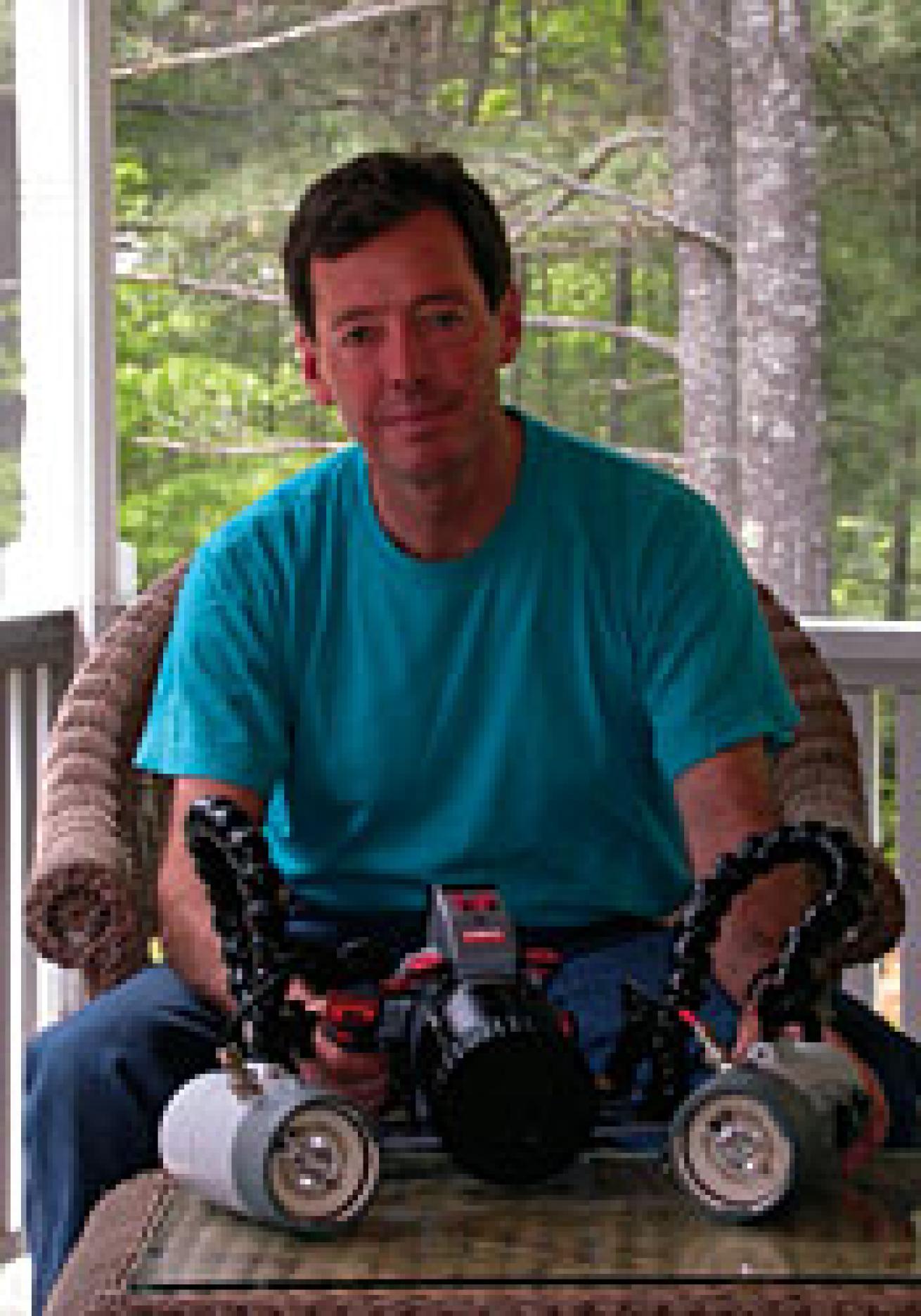
What He Shoots: Subeye Reflex
Strobes: Ikelite DS-125, Ikelite 200 substrobe
I've been taking pictures underwater for over 30 years. In this time I've made exactly one change in my core camera system. I started with Canon F1s and stayed with them for more than 20 years. I am now using the Subeye Reflex, the camera I will continue to use until I retire or die, whichever comes first. The Subeye is a simple film camera that offers the widest range of lens choices of any underwater camera ever made. It can accept any Nikon AF lens with appropriate port, plus all the Nikonos RS water-contact lenses, but it does not permit autofocus with either. Instead, it offers a thumb-controlled power manual focus. The Subeye's sole "advanced" feature is TTL strobe exposure control. Additionally, it has power wind, a shutter speed control, an aperture control, an ISO control that is also used for exposure compensation when shooting TTL strobe, and of course a trigger. And that's it. It's unencumbered by any of the bells and whistles that I find unnecessary to take a good photo in the first place. My strobes of choice for close-up photography are the compact Ikelite DS-125s with their lightning-fast recycle time. For wide-angle, I prefer the increased power and beam angle of the Ikelite 200 substrobes.
Amos Nachoum
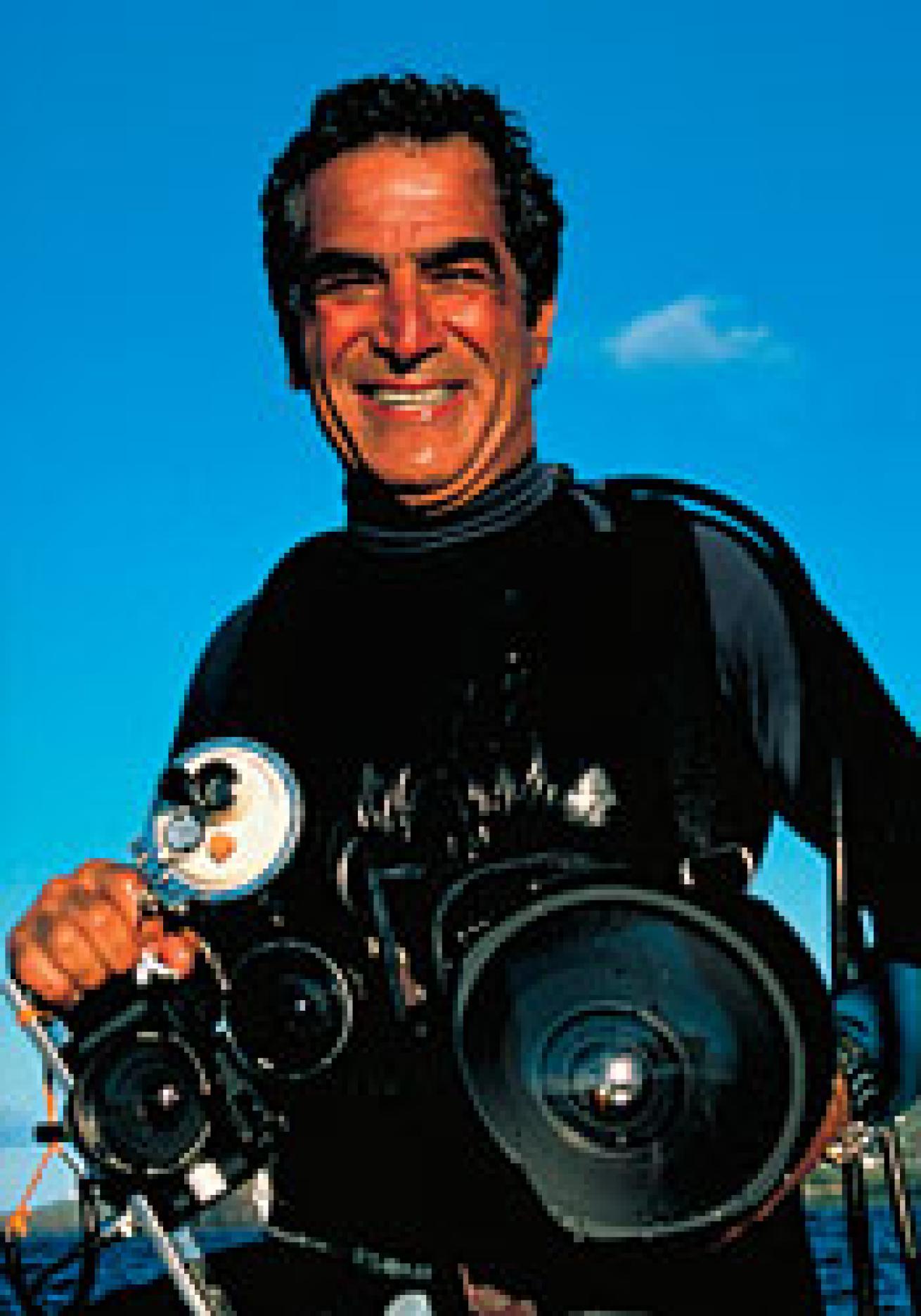
What He Shoots: Nikonos RS, Nikonos III
I still use the Nikonos RS thanks to the excellent optics this camera features. It has an excellent light meter and a large viewfinder, which is critical for capturing big animals at my advanced age. I also still use the Nikonos III with the 15mm and 20mm lenses, which offer superb optics. Both cameras are always reliable and very easy to handle and put together in any environment from the North Pole to Antarctica. These two cameras are superb to work with in blue water and particularly with big animals. I've resisted moving to digital, in part because of cost, in part because digital images seem two-dimensional to me, while film renders a more three-dimensional feel that's more appealing to me.
Brandon Cole
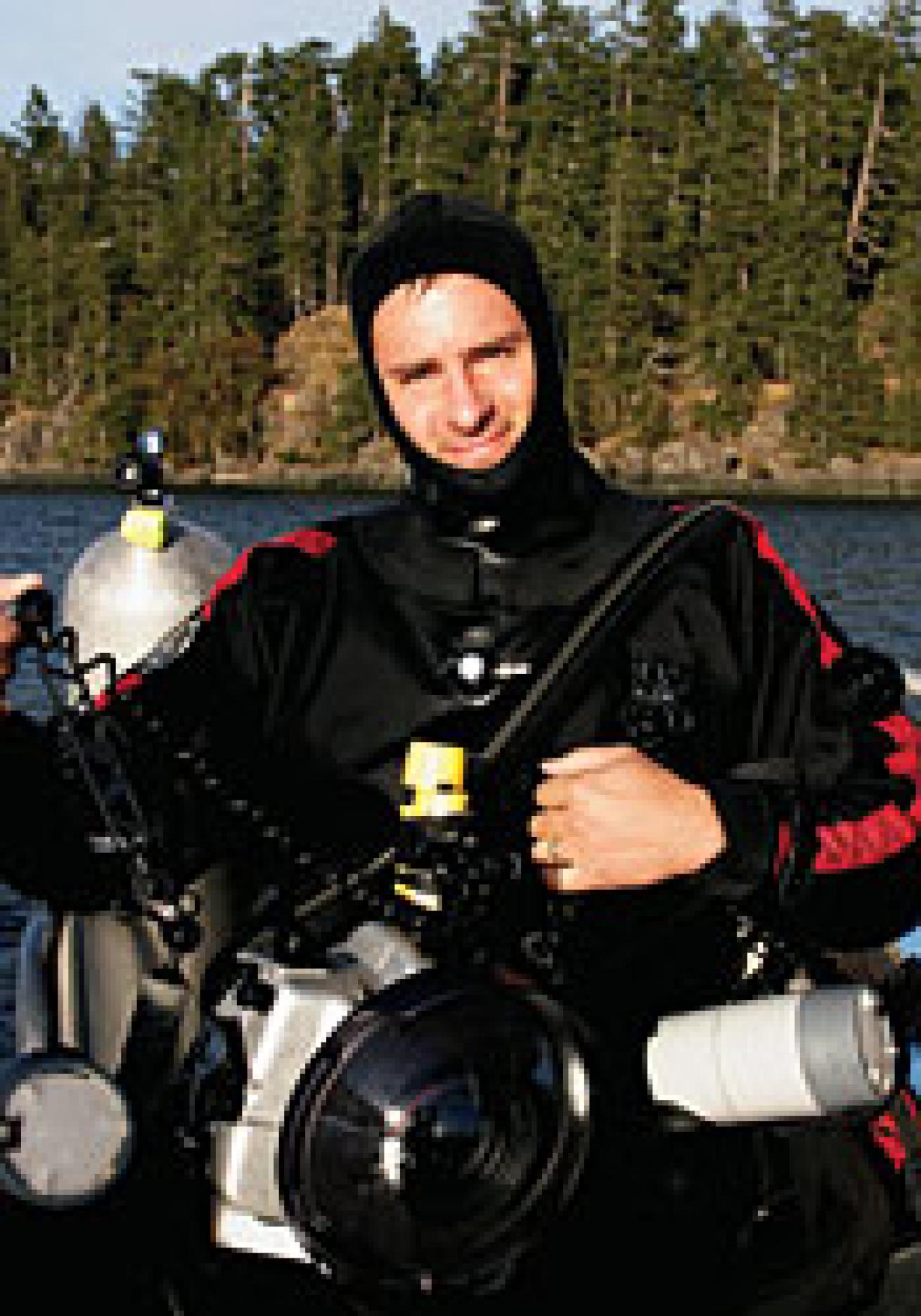
What He Shoots: Canon EOS-1DsMKII and Canon EOS 5D
Housing: Seacam
Strobes: Ikelite DS-125 and 200
The last few years have seen me changing photo gear at a frenzied pace. Seems I've hardly had time to learn the nuances of one camera before moving on to the next. I've recently transitioned exclusively to full-frame digital SLRs and hope to stick with these for a year or two.
My lens arsenal is always being fine-tuned. As I shoot primarily big animals and wide-angle scenes, full-frame fisheye, 17mm, 20mm primes and the 17-40mm zoom get the most action. Like many others, I'm on a quest for wide-angle lenses that hold up to the demands of full-frame sensors. Austrian-made Seacam housings remain my first choice to keep cameras dry. When I need to bring the sun underwater, I turn to Ikelite DS125 and 200 substrobes for their reliability and the company's stellar customer service.
Eric Cheng
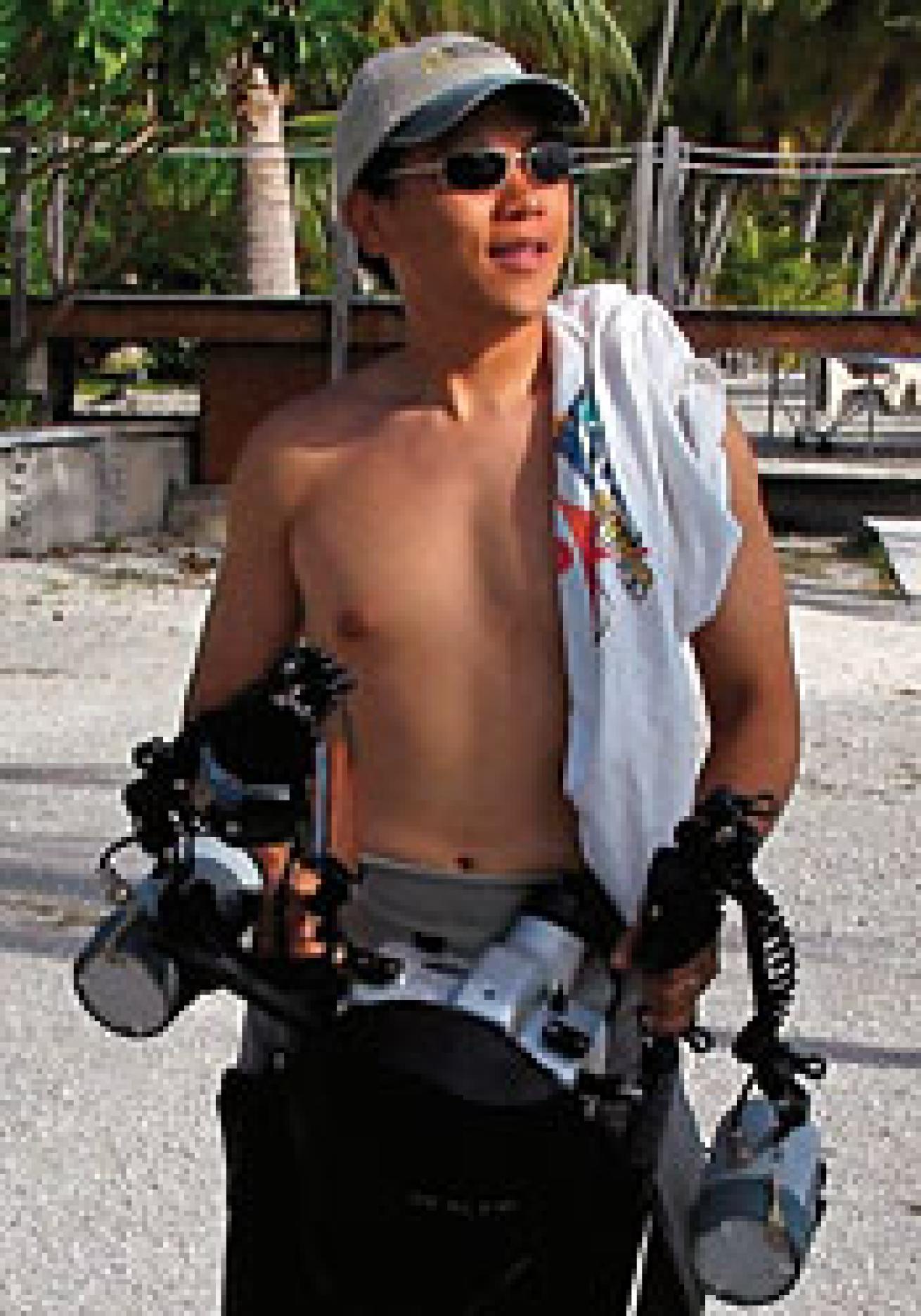
What He Shoots: Canon EOS-1DsMKII
Housing: Seacam
Strobes: Ikelite DS-125
I shoot with a Canon EOS-1DsMKII in a Seacam underwater housing, with Ultralight arms and Ikelite DS-125 strobes for lighting. I love Seacam housings because everything is always right at my fingertips. I can zoom, focus, change both aperture and shutter speed, and trigger the shutter without moving either of my hands away from their position gripping the handles. The Ikelite DS-125 strobes are a good compromise between size, battery life, beam angle and power. Most of the time these days, I feel like I've achieved underwater equipment nirvana, which is to feel like I never have to think about what I shoot. Gear should never get in the way between me and an image I want to capture!
Flip Nicklin
What He Shoots: Nikon D2X
Housing: Nexus
I have changed systems every year for the last three years. The big files and bigger buffer on the D2X really make a difference. Being down deep on a free dive near a whale and waiting after shooting four frames got pretty old. Also on the D2X housing, I can see through the viewfinder very well. The D70 was terrible--lucky for me that whales are big and I usually shoot pretty wide. I use big ports with extenders to match them up well with the lens.
Eric Hanauer
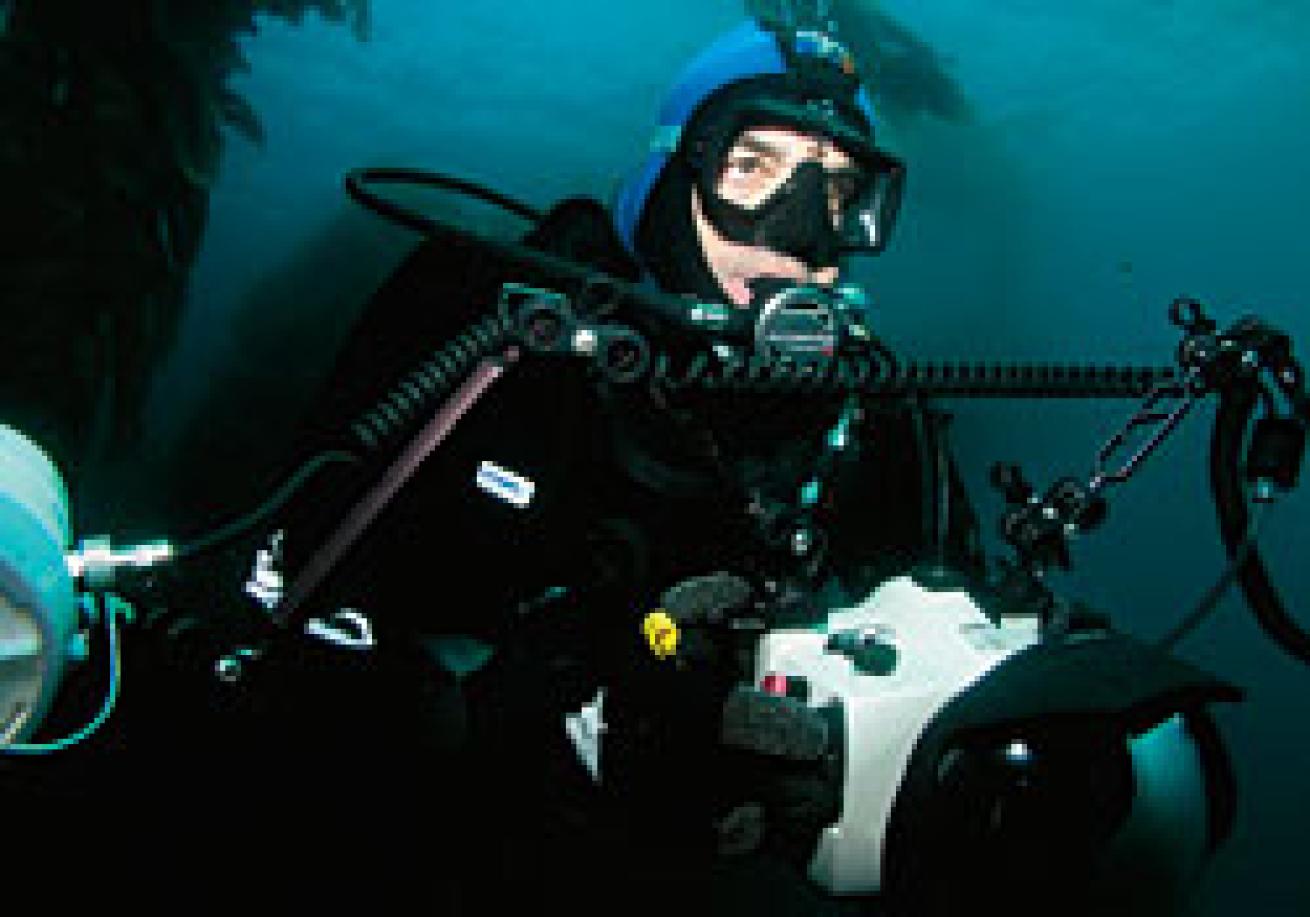
What He Shoots: Nikon D100
Housing: Subal
Strobes: Ikelite DS-125
By the time you read this, I will have updated to a Nikon D200 and a Subal housing. I've been shooting a D2X topside, and the D200 offers the same fast, accurate autofocus and metering, along with 10-megapixel resolution. It will be my fourth Subal housing. I really like the compact size of the Subal because it handles like a camera instead of like a housing. I've been using Ikelite strobes ever since the 150, and these are the best yet, with soft, even, warm light and incredibly quick recycle times.
David Fleetham
What He Shoots: Canon EOS 20D
Housing: Ikelite
Strobes: Ikelite DS-125
I am currently shooting with a Canon EOS 20D in an Ikelite housing with twin Ikelite substrobes. I tested Ikelite's digital TTL 125 substrobes when they first perfected the electronics with the 20D. I was so impressed I've been clicking away with the same system ever since.
I now shoot most of my wide-angle in TTL and even when the subject does not fill the frame, the TTL strobes still get it 99 out of 100 times. The Canon 5D is in my very near future and I'll put it in an Ikelite housing again. I miss my true full-frame fisheye and will go for the 5D to get it back.
Andy Sallmon
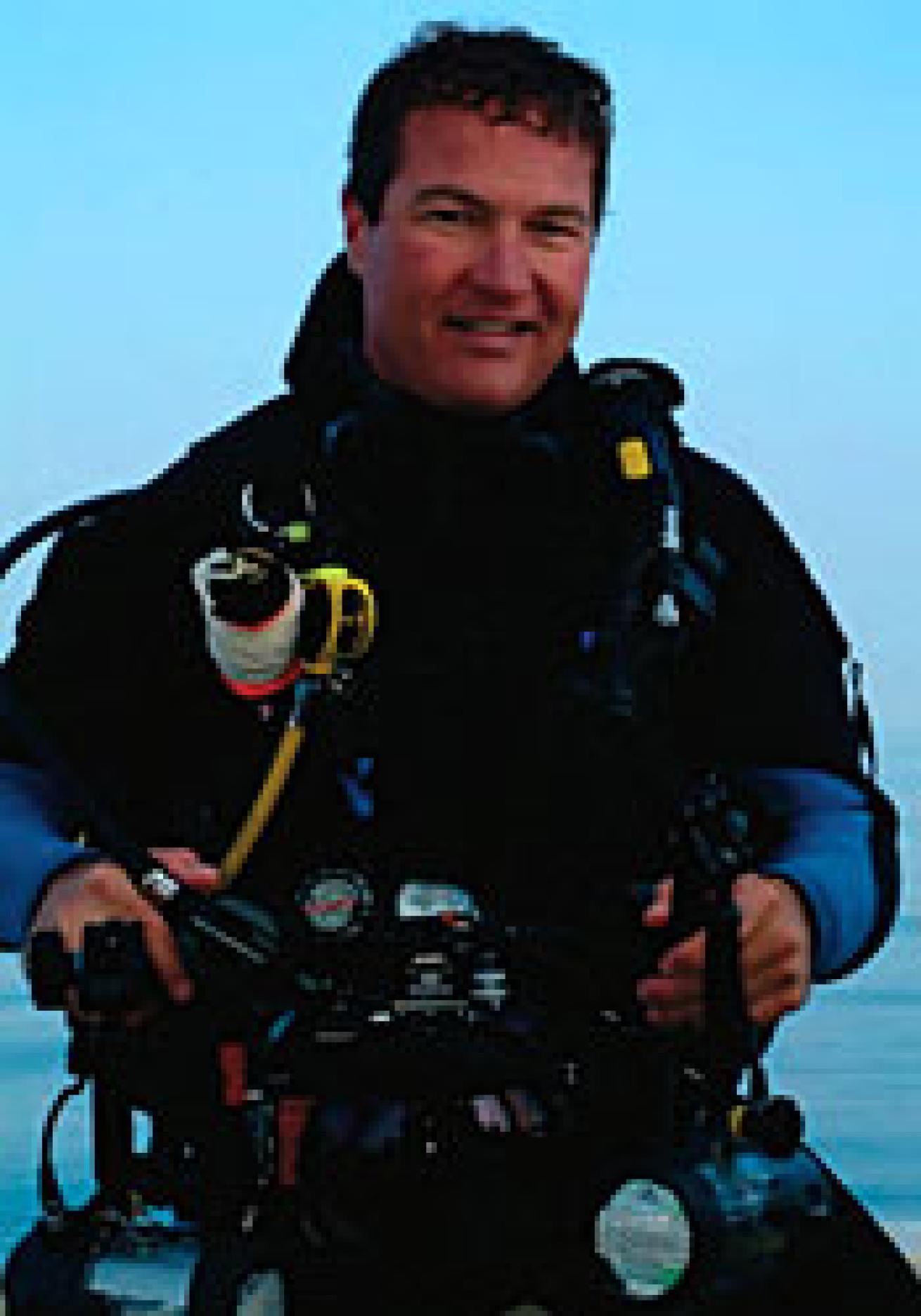
What He Shoots: Canon EOS 5D, Canon EOS 20D
Housings: Aquatica and Sea & Sea
Strobes: Sea & Sea YS-120
I am a recent Canon convert. I really like the full-frame sensor and small size of the 5D. Canon seems to have a faster, more responsive autofocus and I also like the low noise and "smooth" look from their CMOS sensor. The 5D handles beautifully underwater in both the new Aquatica housing and the new Sea & Sea housing. I like the Aquatica's handles--the best of all handles in the industry--and have heard that they will eventually produce a magnified viewfinder. The Sea & Sea housing just "landed" in the U.S. It is a little smaller than the Aquatica and will soon have i-TTL capability with the new Sea & Sea Canon TTL converter. The small size and weight of both of these housings make them equally great whether packing them for travel or swimming after dolphins.
My underwater lens choices for wide-angle are the 15mm full-frame fisheye and the 20mm wide-angle. I love the 180-degree viewing angle of the 15mm for reef scenics, wrecks and large animals like whales and whale sharks. The 20mm is a favorite wide-angle at 94 degrees as it's not too wide but forces you to work close to your subject. I like this lens for sharks and dolphins, yet it's wide enough for some reef scenics.For macro, I prefer the Canon 100mm USM IF. It's got the fastest autofocus response in a macro lens that I've ever used.
Since I travel a lot and compactness and weight are always an issue, I have room for only one telephoto lens. For this application, I have found the Canon 100-400 IS tele-zoom to be the best single lens that I could carry. It offers a long focal length with my 20D body, which is now my topside camera, and the image stabilization comes in handy when shooting in low-light situations where high shutter speeds are not needed.
Rod Klein
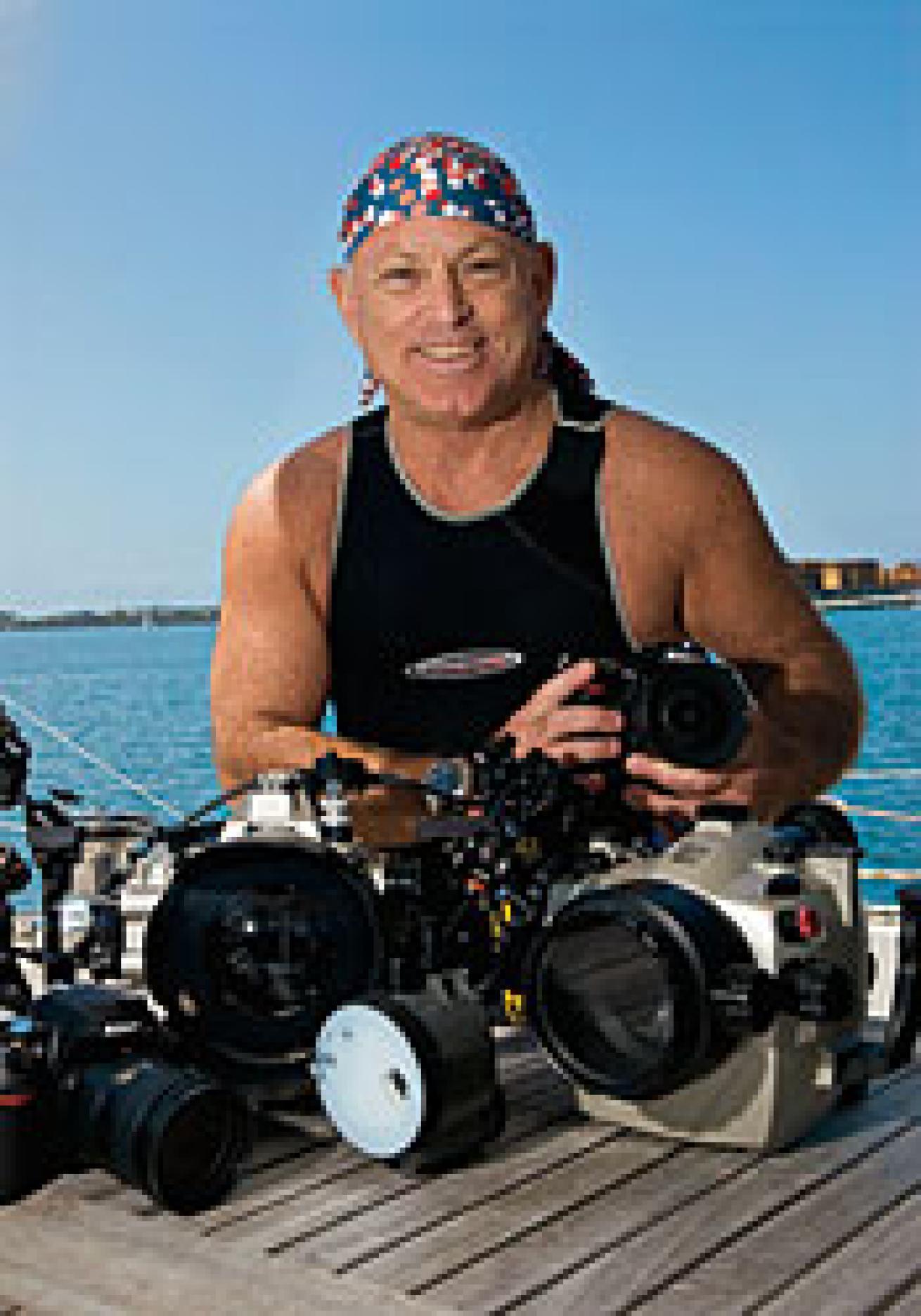
What He Shoots: Nikon D2X
Housings: Subal and Nexus
Strobes: Inon 220 and 240 series
A longtime Nikon shooter, I have progressed from the D100 to the D2X. In fact, I have two D2X cameras for underwater and a D200 for general-purpose use. While some photographers prefer cameras with a full-frame image sensor, I like Nikon's smaller DX sensor technology. Considering that Nikon has created wide-angle lenses specifically for the smaller DX sensor, I feel I get more bang for my buck when shooting macro and still have all the lenses I need for wide-angle situations.
I use a Subal housing for my D2X. It's extremely well-built with virtually every camera control available, a very convenient removable camera tray, easy-access lens release, and what I consider to be the easiest latching system to use. I love this housing, especially for macro work. I recently added a Nexus D2X housing to my arsenal, primarily for wide-angle use. It's an extremely small housing and has a newly designed glass wide port that measures only six inches but will accommodate all of the Nikon wide lenses. This makes for very easy packing and reduced weight. It's great for one-hand shooting.
I've been a confirmed Inon strobe user since the first 220 series strobes were introduced. They're half the size of a Nikonos 105, but have more power, multipower settings, and 100-degree coverage, so I can easily pack four strobes in the same space that two larger strobes might take. And because they are so small, I actually use three strobes when shooting wide-angle, which gives me better lighting control in the center of the frame. I recently added the new Inon 240 series strobes to my system. They have a higher guide number and a built-in pointer light that is completely separate from the camera shutter electronics.
David Doubilet

(text by Jennifer Hayes)
What He Shoots: Nikon F100, Nikon F4, Nikon D100, Nikon D70, Nikon D2X
Housings: Nexus and Seacam
Strobes: Sea & Sea YS-200 YS-120, YS-350, DX-90
David is shooting about 80 percent digital on assignment with the exception of panoramic and black-and-white imagery. David is digitally armed with the Nikon D100 through the D2X housed in Nexus and Seacam Housings and uses Sea & Sea YS-350 and DX-90 strobes on Aquatica arms. His bag is crowded with a complement of lenses ranging from 10.5mm Nikon AF-D through to the 105mm Nikon complete with backups and a handy 300mm Nikon for just-in-case surface moments.
His film-related gear has been modified to Nikon F100s, F4s in Nexus housings and the Hasselblad X-pan Panoramic in a custom housing. David still relies on his favored Sea & Sea YS-200 strobes equipped with wet connectors and backs them up with Sea & Sea YS-120s.
Walt Stearns

What He Shoots: Canon EOS 5D
Housing: Subal
Strobes: Sea & Sea YS-120
Among the criteria I used in selecting a housing were the overall balance, weight and size of the housing, the construction and operational ergonomics of the camera controls and the availability of optics that would allow for expansion and maximum versatility. Because I am now shooting with Canon's compact 12.8-megapixel powerhouse, the 5D, Subal's just-released housing was the most obvious choice. It's small and lightweight, making it relatively travel-friendly. Furthermore, it's well- balanced and offers easy access to the camera's controls. But most important of all, it includes premium-quality ports. Between Subal's FE2 optical-grade-glass dome port and macro port with a couple of extension rings, I am able to use premium optics such as Canon's 15mm full-frame fisheye, 17-40mm wide-angle zoom, 24mm prime and 100mm macro. The transition to digital hasn't changed my lighting needs. I still use dual Sea & Sea YS-120 strobes, set on a pair of TLC arms.
Paul Nicklen

What He Shoots: Canon EOS-1DMKII and Canon EOS-1DsMKII
Housings: Seacam
Strobes: Ikelite DS-125
All of the assignments that I have shot for National Geographic have been in very remote and inhospitable places such as the Arctic and Antarctica. Originally, because of the remoteness and the limitations of film, I used to shoot with five or more film housings. That meant I needed 10 strobes--way too much gear and too many headaches. I have always found underwater photography labor- and gear-intensive.
Two years ago, I switched to the Seacam 1Ds and 1D housings with the fisheye port, superdome and macro port. These are no doubt the Bentleys of underwater housings, and for the first time in a long time, I love taking underwater pictures again. The ease of use, the incredibly sharp images with the mineral glass domes and mostly the unparalleled 180- and 45-degree viewfinders make these housings an underwater photographer's dream.
The 1DMKII system works perfectly with the Canon 16-35mm zoom, and I use the 17-40 zoom on the 1Ds system. I also shoot the 15mm fisheye on either housing and like both the Sigma 50mm and Canon 100mm macro lenses. With the ease of changing my ISO settings underwater and the ability to see what my strobes are doing, I no longer lug around huge strobes. These days, I am very happy with my Ikelite DS-125 digital strobes. Underwater photography is becoming so much fun that I almost feel guilty--but I don't.

